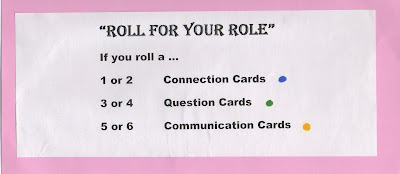My workshop ended up being called: "Cards, Games & Role-play: Making learning fun in Stories, Science & Socials!" I felt the workshop ended up being a lot of fun in comparison to the previous one(s) because I had other teachers actively involved by trading cards and getting involved in a few games. The tell-tale signs were teachers laughing and sharing ideas. I wanted my participants to experience what my classroom is like, as opposed to just hearing or reading about it, since this is how I approach my actual lessons. I don't want my students to just hear me lecture or read textbook information, I want them actively and emotionally engaged in their learning through fun experiences. The ideas I brought (cards, games and role-play) were not just presented as fun "add-on" activities to other lessons; rather I stressed the notion that they can powerful learning tools that create the conditions for students to have emotional connections and responses to learning new concepts.
I will share one idea with you now and maybe others in a later post. It is a game I created for my Language Arts curriculum, specifically for Literature Circles. Traditionally Lit. Circles can be organized where students are grouped by reading ability and they choose a novel together. The purpose of the group is to share the reading and have discussions about the book - to share, ask questions, and clarify with each other. The teacher becomes a facilitator who can move around from group to group implementing some formative assessment work, asking questions and making suggestions with each group or for each individual as needed. I still use this format for the first month, but I have found that after awhile students start to lose focus and interest in their Lit. Circles and in the way they respond. Typically I have students share back to each other through a written response (and I check these after). So sometimes changing the format can re-energize the students into their reading.
The game I introduced is called: "Roll For Your Role". It is very easy to set up and requires very little as far as supplies. The main thing is dice - that alone is often enough to get kids excited because it is a bit unusual to be using dice in a reading activity. Come on, who doesn't like dice!! I chose some clip art for my role cards and developed some initial criteria with the students about what each card means. (Each one is described as a question from top left, to top right, bottom left, then bottom right.)
 |
Instruction Card |
 |
Question CardsWhat would each of the following characters ask? What does it sound like when they ask a question?(a superhero? a detective? a robot: facts only? a reporter?) |
 |
Communication CardsWhat does each of the following characters look for? What do they value in a story?(a superhero? a robot? a reporter? a detective?) |
 |
| Choosing their role responses |
 |
| Sharing and discussing elements of the story |
 |
| Rolling to see what happens next |
 |
| Acting out a response is a lot of fun! |
You should see my students eagerness to read and the laughter we hear in the classroom. They are so excited about playing the game that they want to get through their reading so they can share what they read, thought and/or felt about it.
I have left out much of the explanation of the theory or reasoning as to why I have included certain "roles" in order to keep it simple for you to try in your own class; but the use of super heroes, reporters, detectives etc... are purposeful choices for me, because children at this age are fascinated with the heroic and mysterious aspects of reality. I think you get the idea that this is fun because getting into "roles" allows them to play with reality. So whatever pics you choose, make sure to give meaning to each one and even ask your students ones that they might want to find and include.
Using trading cards, games and role-play as part of your instructional "toolkit" will help to deepen emotional connections for students; thus enhancing recall of information, and a deeper and more meaningful understanding of new learning situations. Putting learning into a form that is fun allows students to actively participate in lessons, which is crucial for them to become empowered as learners and take risks.



